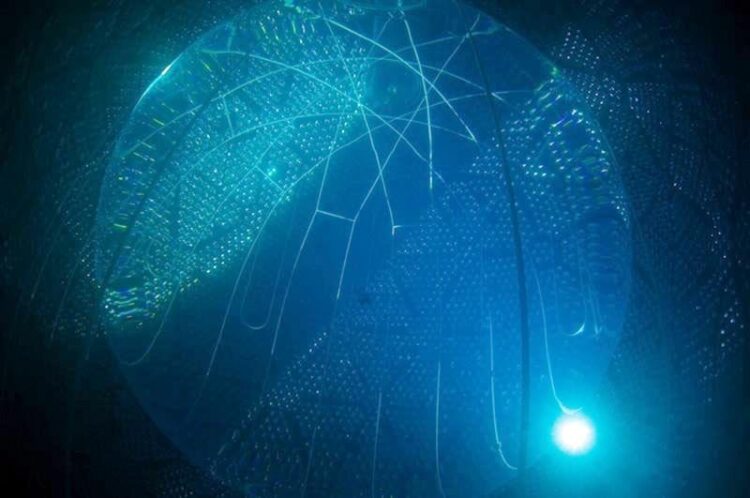Detecting neutrinos from nuclear reactors with water

The SNO+ detector 2 kilometers deep in a mine in Ontario, Canada. The image shows the ropes that hold the 12 m-diameter acrylic vessel filled with 1,000 tons of water and the light sensors that detect tiny amount of light from neutrino interactions.
Image courtesy of the SNO+ Collaboration
The SNO+ experiment has for the first time shown that neutrinos from a nuclear reactor over 240 km away can be detected with plain water.
The Science
Neutrinos are subatomic particles that interact with matter extremely weakly. They are produced in many types of radioactive decays, including in the core of the Sun and in nuclear reactors. Neutrinos are also impossible to block—they easily travel from the core of a nuclear reactor to a detector far away, and even through the Earth itself. Detecting the tiny signals from neutrinos therefore requires huge devices that are extremely sensitive. The SNO+ experiment has just shown that a detector filled with simple water can still detect reactor neutrinos, even though the neutrinos create only tiny signals in the detector.
The Impact
The SNO+ measurement shows that distant nuclear reactors can be observed and monitored with something as simple and inexpensive as water. Reactors cannot shield the neutrinos they produce. This means SNO+’s measurement is a proof of the idea that such water detectors could play a role in ensuring nuclear non-proliferation. Like SNO+, such detectors would still need to be very clean of any radioactivity, large (SNO+ contains 1,000 tons of water), and able to detect the tiny amount of light that the neutrinos produce. The use of water, however, means that very large detectors are possible and a real option for “seeing” even very distant reactors.
Summary
Scientists long thought that the tiny signals (just 10-20 photons) created by reactor neutrinos in a water detector would make it impossible to detect those neutrinos, particularly when the detector was far away from the reactor and the rate of these signals was very low. By ensuring that the detector was clean from even trace amounts of radioactivity, and by having an energy threshold lower than any water detector ever built, SNO+ was able to see these signals and show that they came from nuclear reactors at least 240 kilometers (150 miles) away. The measurement was still quite difficult, as backgrounds (fake events) from residual radioactivity, and from neutrinos created in the atmosphere by cosmic rays, needed to be identified and removed.
Water detectors have several advantages. They are inexpensive and can be very large, making them useful for monitoring reactors across international borders. Improvements to such monitoring, including using water-based liquid scintillator or “loading” the water with gadolinium, both of which would boost the signal size, are being tested by other collaborations. This work is from the SNO+ Collaboration, an international collaboration of roughly 100 scientists from the United States (the University of Pennsylvania, the University of California at Berkeley and Lawrence Berkeley National Laboratory, the University of California at Davis, Brookhaven National Laboratory, Boston University, and the University of Chicago), Canada, the United Kingdom, Portugal, Germany, China, and Mexico. SNO+ is located in SNOLAB, the Canadian underground laboratory.
Funding
SNO+ is funded by the Department of Energy Office of Science, Office of Nuclear Physics and has received funding from the National Science Foundation and the Department of Energy National Nuclear Security Administration through the Nuclear Science and Security program. Funding in Canada comes from Canada Foundation for Innovation, Natural Sciences and Engineering Research Council, Canada Institute for Advanced Research, Queens University, the Ontario Ministry of Research, Innovation and Science, the Alberta Science and Research Investments Program, the Federal Economic Development Initiative for Northern Ontario, and the Ontario Early Researcher Awards. In the United Kingdom, funding has come from the Science and Technology Facilities Council, the European Union’s Seventh Framework Programme under the European Research Council grant agreement, and the Marie Curie grant agreement. Funding has also come from the Fundaçáo para a Ciência e a Tecnologia (FCT-Portugal), the Deutsche Forschungsgemeinschaf in Germany, DGAPA-UNAM and Consejo Nacional de Ciencia y Tecnología in Mexico, and Discipline Construction Fund of Shandong University in China.
Journal: Physical Review Letters
DOI: 10.1103/PhysRevLett.130.091801
Method of Research: Experimental study
Subject of Research: Not applicable
Article Title: Evidence of Antineutrinos from Distant Reactors Using Pure Water at SNO +
Article Publication Date: 1-Mar-2023
Media Contact
Michael Church
DOE/US Department of Energy
michael.church@science.doe.gov
Office: 2028416299
All latest news from the category: Physics and Astronomy
This area deals with the fundamental laws and building blocks of nature and how they interact, the properties and the behavior of matter, and research into space and time and their structures.
innovations-report provides in-depth reports and articles on subjects such as astrophysics, laser technologies, nuclear, quantum, particle and solid-state physics, nanotechnologies, planetary research and findings (Mars, Venus) and developments related to the Hubble Telescope.
Newest articles

NASA: Mystery of life’s handedness deepens
The mystery of why life uses molecules with specific orientations has deepened with a NASA-funded discovery that RNA — a key molecule thought to have potentially held the instructions for…

What are the effects of historic lithium mining on water quality?
Study reveals low levels of common contaminants but high levels of other elements in waters associated with an abandoned lithium mine. Lithium ore and mining waste from a historic lithium…

Quantum-inspired design boosts efficiency of heat-to-electricity conversion
Rice engineers take unconventional route to improving thermophotovoltaic systems. Researchers at Rice University have found a new way to improve a key element of thermophotovoltaic (TPV) systems, which convert heat…



